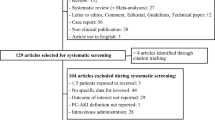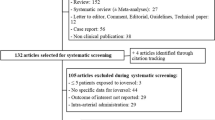Abstract
Objectives
While hypersensitivity reactions (HSR) to intravenously administered iodinated contrast media (ICM) have been well studied, not much is known about HSR to intra-arterially administered ICM.
Methods
A prospective observational study was performed to evaluate coronary angiography (CAG)-induced ICM hypersensitivity in patients who underwent CAG using ICM including ioversol, a low-osmolar non-ionic monomer, and iodixanol, an iso-osmolar non-ionic dimer. The HSR were investigated through in-patient monitoring after CAG and telephone interview after discharge.
Results
A total of 714 patients were enrolled during the observation period, of whom 26 (3.6%) showed immediate HSR and 108 (15.1%) showed delayed HSR. With regard to severity, proportion of immediate HSR grades 1, 2, and 3 was 57.7%, 38.5%, and 3.8%, respectively, whereas that of delayed HSR grades 1, 2, and 3 was 85.2%, 13.9%, and 0.9%, respectively. Multivariate analysis revealed that previous intra-arterial exposure to ICM was an independent risk factor for immediate HSR (odds ratio (OR) 2.92, 95% confidence interval (CI) 1.22–6.96; p = 0.015). Iodixanol was a significant risk factor for delayed HSR (OR 1.61, 95% CI 1.07–2.43; p = 0.024) and correlated with a higher incidence of delayed HSR within 24-h post-ICM administration compared to ioversol.
Conclusion
The incidence rate of immediate and delayed HSR in intra-arterially administered ICM was 3.6% and 15.1%, respectively. Previous exposure to intra-arterially administered contrast media was a significant risk factor for immediate HSR. Compared to ioversol, iodixanol was associated with relatively earlier and more frequent delayed HSR.
Key Points
• In this prospective study, the incidence of immediate and delayed hypersensitivity in intra-arterial injection of contrast media during coronary angiography was 3.6% and 15.1%, respectively.
• Delayed hypersensitivity reactions were more common but less severe than immediate hypersensitivity reactions during coronary angiography.
• Previous exposure to ICM via intra-arterial route was a significant risk factor for immediate hypersensitivity to intra-arterial contrast medium.


Similar content being viewed by others
Change history
18 February 2020
The original version of this article, published on 01 April 2019, unfortunately contained a mistake. The presentation of Fig. 1 was incorrect. The corrected figure is given below.
Abbreviations
- CAG:
-
Coronary angiography
- CI:
-
Confidence interval
- CT:
-
Computed tomography
- HSR:
-
Hypersensitivity reactions
- IA:
-
Intra-arterial
- ICM:
-
Iodinated contrast media
- IV:
-
Intravenous
- OR:
-
Odds ratio
References
Gleeson TG, Sudi B (2004) Contrast-induced nephropathy. AJR Am J Roentgenol 183:1673–1689
Brockow K, Ring J (2010) Classification and pathophysiology of radiocontrast media hypersensitivity. In: Ring J (ed.) Anaphylaxis. Karger Publishers, pp 157–169
Brockow K (2012) Immediate and delayed cutaneous reactions to radiocontrast media. In: French LE (ed.) Adverse cutaneous drug eruptions. Karger Publishers, pp 180–190
Bellin MF, Stacul F, Webb JA et al (2011) Late adverse reactions to intravascular iodine based contrast media: an update. Eur Radiol 21:2305–2310
Caro JJ, Trindade E, McGregor M (1991) The risks of death and of severe nonfatal reactions with high-vs low-osmolality contrast media: a meta-analysis. AJR Am J Roentgenol 156:825–832
Katayama H, Yamaguchi K, Kozuka T, Takashima T, Seez P, Matsuura K (1990) Adverse reactions to ionic and nonionic contrast media. A report from the Japanese committee on the safety of contrast media. Radiology 175:621–628
Kim TH, Yoon SH, Lee SY et al (2018) Biphasic and protracted anaphylaxis to iodinated contrast media. Eur Radiol 28:1242–1252
Kim M-H, Lee SY, Lee S-E et al (2014) Clinical features of delayed contrast media hypersensitivity. Allergy Asthma Respir Dis 2:352–357
Webb JA, Stacul F, Thomsen HS, Morcos SK (2003) Late adverse reactions to intravascular iodinated contrast media. Eur Radiol 13:181–184
Savill JS, Barrie R, Ghosh S, Muhlemann M, Dawson P, Pusey CD (1988) Fatal Stevens-Johnson syndrome following urography with iopamidol in systemic lupus erythematosus. Postgrad Med J 64:392–394
Flinck A, Gottfridsson B (2001) Experiences with iohexol and iodixanol during cardioangiography in an unselected patient population. Int J Cardiol 80:143–151
Shehadi WH (1975) Adverse reactions to intravascularly administered contrast media: a comprehensive study based on a prospective survey. Am J Roentgenol Radium Ther Nucl Med 124:145–152
van der Molen AJ, Reimer P, Dekkers IA et al (2018) Post-contrast acute kidney injury–part 1: definition, clinical features, incidence, role of contrast medium and risk factors. Eur Radiol 28:2845–2869
Sakai N, Sendo T, Itoh Y, Hirakawa Y, Takeshita A, Oishi R (2003) Delayed adverse reactions to iodinated radiographic contrast media after coronary angiography: a search for possible risk factors. J Clin Pharm Ther 28:505–512
Sutton AG, Finn P, Grech ED et al (2001) Early and late reactions after the use of iopamidol 340, ioxaglate 320, and iodixanol 320 in cardiac catheterization. Am Heart J 141:677–683
Brockow K, Christiansen C, Kanny G et al (2005) Management of hypersensitivity reactions to iodinated contrast media. Allergy 60:150–158
Park HJ, Park JW, Yang MS et al (2017) Re-exposure to low osmolar iodinated contrast media in patients with prior moderate-to-severe hypersensitivity reactions: a multicentre retrospective cohort study. Eur Radiol 27:2886–2893
Yoshikawa H (1992) Late adverse reactions to nonionic contrast media. Radiology 183:737–740
Dieterlen MT, John K, Reichenspurner H, Mohr FW, Barten MJ (2016) Dendritic cells and their role in cardiovascular diseases: a view on human studies. J Immunol Res 2016:5946807
Idée J, Corot C (2003) Delayed side effects induced by iodinated contrast media, especially those associated with iodixanol. Eur Radiol 13:644–645
Speck U, Böhle F, Krause W, Martin JL, Miklautz H, Schuhmann-Giampieri G (1998) Delayed hypersensitivity to X-ray CM: possible mechanisms and models. Acad Radiol 5:S162–S165
Torres M, Mayorga C, Cornejo-Garcia J et al (2008) Monitoring non-immediate allergic reactions to iodine contrast media. Clin Exp Immunol 152:233–238
Kanny G, Pichler W, Morisset M et al (2005) T cell–mediated reactions to iodinated contrast media: evaluation by skin and lymphocyte activation tests. J Allergy Clin Immunol 115:179–185
Brockow K, Romano A, Aberer W et al (2009) Skin testing in patients with hypersensitivity reactions to iodinated contrast media–a European multicenter study. Allergy 64:234–241
Vernassiere C, Trechot P, Schmutz JL, Barbaud A (2004) Low negative predictive value of skin tests in investigating delayed reactions to radio-contrast media. Contact Dermatitis 50:359–366
Solomon R (2005) The role of osmolality in the incidence of contrast-induced nephropathy: a systematic review of angiographic contrast media in high risk patients. Kidney Int 68:2256–2263
Jo SH, Youn TJ, Koo BK et al (2006) Renal toxicity evaluation and comparison between visipaque (iodixanol) and hexabrix (ioxaglate) in patients with renal insufficiency undergoing coronary angiography: the RECOVER study: a randomized controlled trial. J Am Coll Cardiol 48:924–930
Morcos SK, Thomsen HS, Webb JA (1999) Contrast-media-induced nephrotoxicity: a consensus report. Eur Radiol 9:1602–1613
Tao SM, Kong X, Schoepf UJ et al (2018) Acute kidney injury in patients with nephrotic syndrome undergoing contrast-enhanced CT for suspected venous thromboembolism: a propensity score-matched retrospective cohort study. Eur Radiol 28:1585–1593
James MT, Ghali WA, Knudtson ML et al (2011) Associations between acute kidney injury and cardiovascular and renal outcomes after coronary angiography. Circulation 123:409–416
McCullough PA, Wolyn R, Rocher LL, Levin RN, O’Neill WW (1997) Acute renal failure after coronary intervention: incidence, risk factors, and relationship to mortality. Am J Med 103:368–375
Aspelin P, Aubry P, Fransson SG, Strasser R, Willenbrock R, Berg KJ (2003) Nephrotoxic effects in high-risk patients undergoing angiography. N Engl J Med 348:491–499
Funding
The authors state that this work has not received any funding.
Author information
Authors and Affiliations
Corresponding authors
Ethics declarations
Guarantor
The scientific guarantor of this publication is Hye-Ryun Kang.
Conflict of interest
The authors of this manuscript declare no relationships with any companies whose products or services may be related to the subject matter of the article.
Statistics and biometry
No complex statistical methods were necessary for this paper.
Informed consent
Written informed consent was obtained from all patients in this study.
Ethical approval
Institutional Review Board approval was obtained (the Institutional Review Board of Seoul National University Hospital (IRB No. 1412-052-632).
Methodology
• prospective
• observational
• performed at one institution
Additional information
Publisher’s note
Springer Nature remains neutral with regard to jurisdictional claims in published maps and institutional affiliations.
Rights and permissions
About this article
Cite this article
Sohn, KH., Kim, GW., Lee, SY. et al. Immediate and delayed hypersensitivity after intra-arterial injection of iodinated contrast media: a prospective study in patients with coronary angiography. Eur Radiol 29, 5314–5321 (2019). https://doi.org/10.1007/s00330-019-06138-3
Received:
Revised:
Accepted:
Published:
Issue Date:
DOI: https://doi.org/10.1007/s00330-019-06138-3




